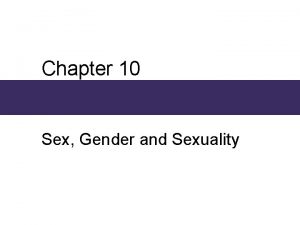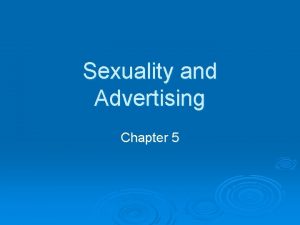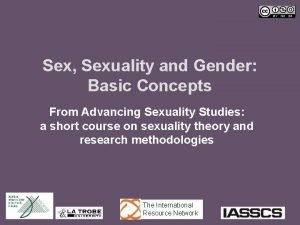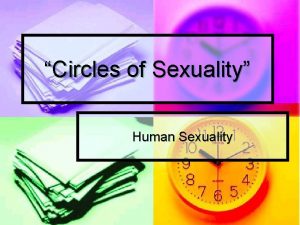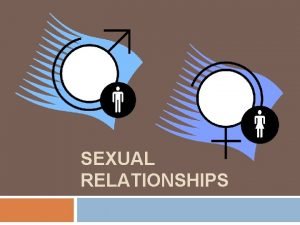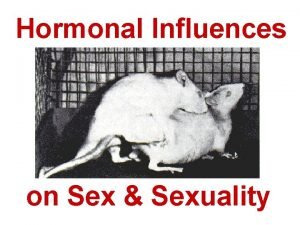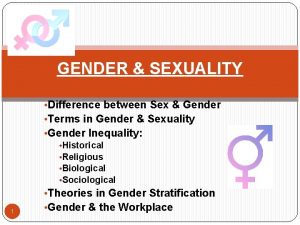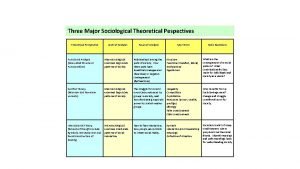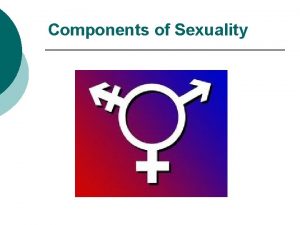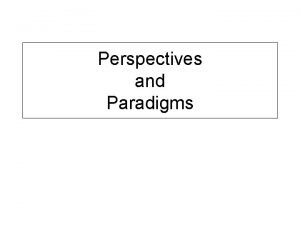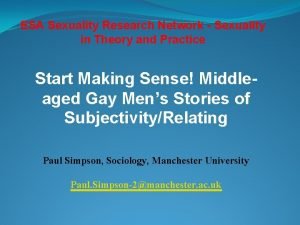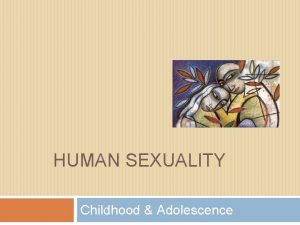Chapter 1 Perspectives on Sexuality Sexuality Why study




















- Slides: 20

Chapter 1 Perspectives on Sexuality

Sexuality • Why study sexuality? • How much do you know about human sexuality?

Sexual Intelligence • Four components of sexual intelligence – – Understanding self Having interpersonal sexual skills and integrity Obtaining accurate scientific sexual knowledge Having consideration of the cultural context of sexuality • Increasing sexual intelligence will allow for responsible decisions in sexual behavior

Studying Sexuality: From a Psychosocial Orientation A psychosocial orientation takes into account • Psychological factors - Emotions, attitudes, motivations • Social conditioning factors - Process with which we learn our social norms • Biological factors - Hormones, nervous system, genetics, etc.

Controversy and Diversity in Human Sexuality Why do the authors attempt to bring an inclusive approach to Our Sexuality? What factors contribute to diversity and similarity of sexual attitudes and behaviors within the United States?

Diversity in the United States

Cross-Cultural Perspectives Islamic Middle East • Based on beliefs of Muhammad • Belief that sex should be enjoyed by both sexes • Women viewed inherently more sexual than men (this power contained by veils, segregation, female circumcision) • Oppression of women and many sexually related restrictions stem from patriarchal cultural traditions and fundamentalist sects, not from religion and the teaching of the Qur’an

Cross-Cultural Perspectives China • Ancient China – Produced the earliest known sex manuals – Under Taoism, sexual activity was promoted for spiritual growth and harmony – The sexual connection of men and women was believed to join the opposing forces of yin and yang

Cross-Cultural Perspectives China • Sexual conservatism with communist rule (1949) – Lack of basic information about sexuality – Sex outside of marriage and frequent sex within marriage discouraged – Almost no STDs • Current trends – – Increasing rates of premarital sex Increasing rates of HIV infection Slightly more open to homosexuality Still lack sexual knowledge and safe-sex skills

Our Cultural Legacy Two Themes • Sex for procreation – Definition of sex and intercourse used synonymously • Male and female gender roles What importance do the historical themes of sex for procreation and male/female gender roles have today?

Sexuality in the Western World Judeo-Christian Perspective • Ancient Hebrews – Gender roles highly specialized – Sex within marriage a necessity • Christianity – Spirituality through celibacy – Sex outside of marriage as sinful – Contradictory images of women emerged • Virgin Mary: compassionate, pure, & unattainable • Eve: evil temptress

Positive Shift in Thinking • Protestant reformation – Temporary increase in respect for women • Enlightenment; scientific rationalism – Value of sex in marriage, goes beyond procreation

Sexual Attitudes Victorian Era • Women’s role constrained; women as asexual • Emotional & physical distance between husband wife • Prostitution flourished • Continued polarized view of women as Madonna or whore • Mosher’s research contradicts prevailing view -Victorian women experienced sexual desire, enjoyed intercourse, and experienced orgasm

20 th Century Sexuality • The beginning of the 20 th century – Suffrage movement – 19 th amendment gives women the right to vote • World War II – Gender roles were expanded & more flexible – Postwar return to stricter roles

20 th Century Sexuality • The 1960 s and 1970 s – The “sexual revolution” – Attitudes begin to change toward homosexuality

The Media and Sexuality How have mass media reflected and influenced sexual norms? What elements are unique to sexuality on the Internet compared with other mass media?

The Media and Sexuality • Media – News, advice, and educational programs – Increased access to sexual material • Percentages of sexual content – Cable and music videos – Video games – Determining of social norms

Sexual Taboos and Television

Cyberspace and Sexuality • 2 billion Internet users worldwide • 80% of people obtain health information from Internet • Source of sexual expression • Facebook, Twitter, Tinder, Yik Yak • Availability on handheld devices – PDAs, i. Pods, cell phones

Sexuality Where the Personal is Political • Impact of social norms • Freedoms and responsibilities today • Controversies facing human sexuality How can something as personal as sex be political?
 Why why why why
Why why why why Chapter 10 sex gender and sexuality
Chapter 10 sex gender and sexuality Don't ask why why why
Don't ask why why why Nelson science perspectives 9 online textbook
Nelson science perspectives 9 online textbook Sexuality in advertising
Sexuality in advertising Definition of sexuality
Definition of sexuality Pretest: growth, development, and sexuality
Pretest: growth, development, and sexuality Circle of sexuality
Circle of sexuality Definition of sexuality
Definition of sexuality Definition of sexuality
Definition of sexuality Which illustrates an emotional aspect of teen sexuality?
Which illustrates an emotional aspect of teen sexuality? Peer sexuality support programme
Peer sexuality support programme Base of uterus
Base of uterus Sexuality spectrum
Sexuality spectrum Sex
Sex The difference between sex and gender
The difference between sex and gender Why study financial institutions
Why study financial institutions Mussolini death
Mussolini death Perspective strategy example
Perspective strategy example Help
Help Theoretical perspectives in sociology
Theoretical perspectives in sociology

